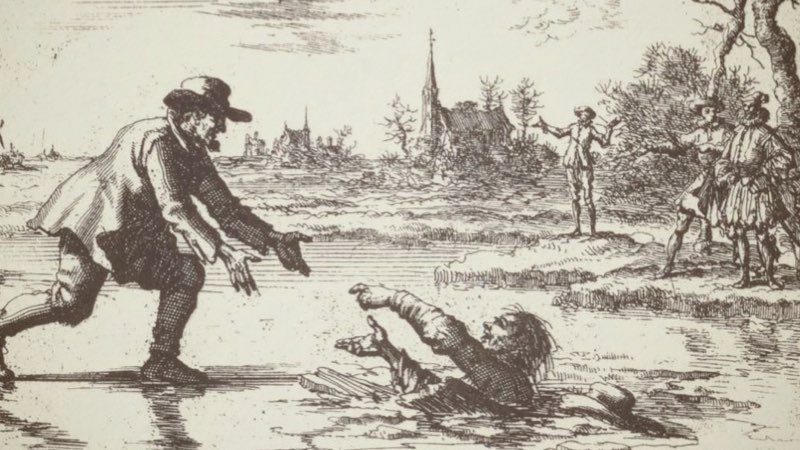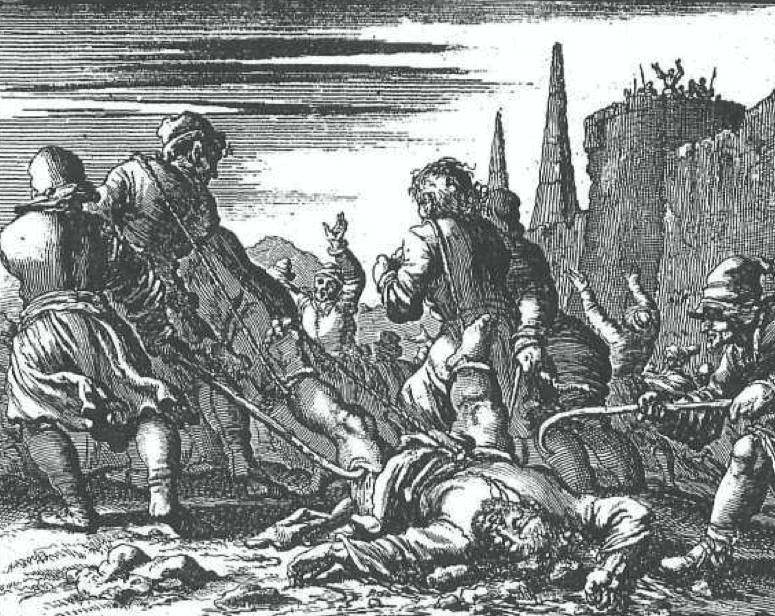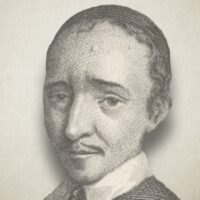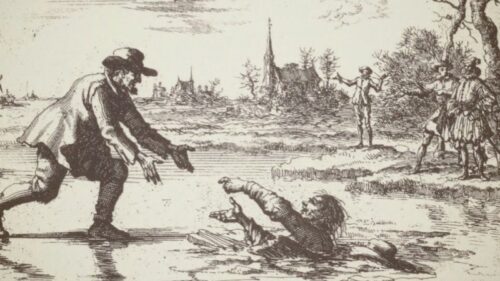
27. Mark, the Evangelist
Mark the Evangelist dies on the way while being dragged to the site of his burning, Alexandria, A. D. 64
How Mark, the Holy Evangelist, Dragged to the Stake at Alexandria, Died on the Way, A.D. 64
The holy evangelist Mark is supposed by most to have been that Mark whose surname in Holy Scripture is John. He was of the circumcision, and a nephew of Barnabas, whose mother was called Mary, a very godly woman, who gave her house in Jerusalem for the assembling of Christians. Acts 12:12; Col. 4:10. Niceph. lib. 2. cap. 33.
He was first appointed a servant of Paul and Barnabas, but on a journey to Pamphylia he returned to Jerusalem. Acts 12:25; 13:13.
Afterwards the apostle Paul recommended him to the church at Colosse, requesting them to receive him as a fellow worker in the kingdom of God. He also commanded Timothy, to bring Mark to him, since he was very profitable to him in his ministry. Col. 4:10; 2 Tim. 4:11.
This Mark was in prison with Paul, and rendered him all faithful assistance in his bonds. Philem. verses 23, 24.
The apostle Peter in his epistle to the elect scattered strangers, calls Mark his son, 1 Pet. 5:13; undoubtedly, because through the Gospel, he had Regenerated him in Christ: or, because he was his disciple, interpreter, and the writer of the Gospel which he had taught; of which latter circumstance Jerome speaks thus: “Mark, a disciple of Peter, at the request of the brethren at Rome, wrote a brief Gospel, according to that which he had heard Peter relate. When Peter had examined it, he pronounced it good, and upon his word gave it to the church to read.” Catalog. Marc, ex CI. Al Hypor. 6. Also, Euscb. lib. 2. cap. 18, ex Clenw Al. and Papio Hierapolit.
Afterwards, when Mark was sent by Peter to Egypt, he traveled through Aquilea, the capital city of Friol, where he converted many to the faith, and left Hermagoras as pastor over the church. Avcnt. an. Boi. lib. 2.
Then he journeyed to Africa, filling Lybia, Marmorica, Ammonica, and Pentapolis with the doctrine of the holy Gospel. Finally he remained several years at Alexandria, where he made his abode. Nic. lib. 2. cap. 43 Athan. in Synopsi.
Concerning the end of his life, Gelasius states, that he died there as a martyr. Concil. Rom Deer, de lib. Auth. and Apocr. Niceph. lib. 2. cap. 43. Mark, he writes, having been sent by Peter to Egypt, faithfully preached the Word of truth there, and nobly sealed the testimony thereof with his blood. All the ancient and modern, Greek and Latin, martyrologies agree with this.
Histories state the following concerning the manner of his death: That in the eighth year of Nero, when he, at the feast of the passover, preached the blessed remembrance of the suffering and death of Christ, to the church at Alexandria, the heathen priests and the whole populace seized him, and with hooks and ropes which they fastened around his body, dragged him out of the congregation, through the streets and out of the city; so that his flesh everywhere adhered to the stones, and his blood was poured out upon the earth, until he, with the last words of our Saviour, committed his spirit into the hands of the Lord, and expired. Anton, p. 1. cap. 6. 16. Procop. Dia Mctaphr. Ado. 25. Apr. de Pest. A post.
Another ancient writer relates: That he was dragged very inhumanly through the streets, his whole body torn open, so that there was not a single spot on it, which did not bleed; and that they then again thrust him, still alive, into prison, whence he, having been strengthened and comforted by the Lord in the night, was taken out again, and dragged to the place Buculi, they jestingly saying, “Let us lead the buffalo to the buffalo stall.” Konst-tooneel der veertig hecrlijke afbecldingen Christi en der postelen, printed Anno 1609. Alos, Bybelsch Ncemboek, printed Anno 1632, letter M. p. 642. col. 1. 2.
Death having ensued meanwhile, the aforementioned heathen wanted, moreover, to burn him; but as they were prevented by a storm, the Christians buried him. This happened, according to common reckoning, in the eighth year of Nero’s reign, A. D. 64, on the 21st day of April.
Thieleman J. Van Braght (1625-1664) was an Anabaptist who is best known for writing a history of the Christian witness throughout the centuries entitled “The Bloody Theater or Martyrs Mirror of the Defenseless Christians who baptized only upon confession of faith, and who suffered and died for the testimony of Jesus, their Saviour, from the time of Christ to the year A.D. 1660” (1660).
Thieleman J. Van Braght, Martyrs Mirror





